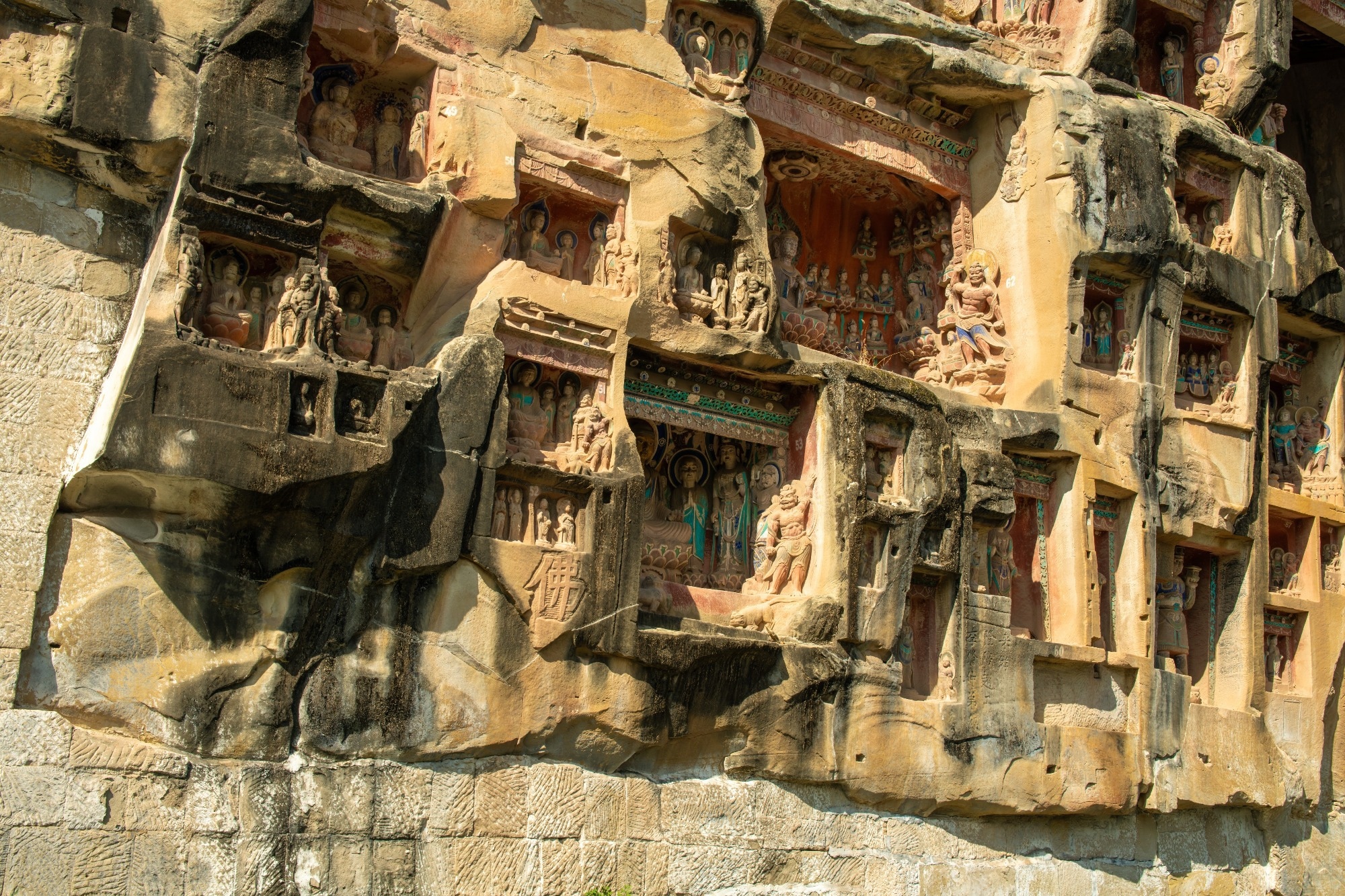In a recent article published in npj Heritage Science, researchers addressed the critical issue of salt weathering in sandstone monuments, focusing particularly on the Nankan Grotto. The study seeks to advance knowledge on salt weathering mechanisms and provide insights for developing more effective conservation strategies tailored to seasonal and environmental conditions.

Image Credit: Tao Jiang/Shutterstock.com
Background
Due to its widespread availability and aesthetic appeal, sandstone has historically been a dominant construction material for cultural heritage sites globally, particularly in religious and artistic contexts. Nevertheless, despite its robustness, sandstone is susceptible to various forms of environmental degradation, among which salt weathering is notably pervasive.
Salt weathering involves the crystallization and growth of salt crystals within the pore structure of stones, exerting pressure that damages the microstructure. Several salts, including sodium sulfate and sodium nitrate, are commonly associated with subflorescence (below-surface crystallization) and efflorescence (surface crystallization), each leading to different damage patterns. Prior research has demonstrated that the type of salt, its concentration, environmental humidity, and temperature notably influence the extent and nature of deterioration.
The Current Study
The researchers utilized sandstone samples from the Nankan Grotto, which are characterized by a mineralogical composition predominantly of quartz and feldspar, with minor calcite and clay minerals. Prior to testing, the samples underwent a comprehensive analysis of their mineralogy, major elemental composition, petrophysical properties, and microstructure.
Standardized procedures were employed, such as X-ray diffraction (XRD) for mineralogy, X-ray fluorescence (XRF) for elemental analysis, and mercury intrusion porosimetry for pore structure. Mechanical properties such as tensile strength were determined via Brazilian splitting tests, while physical parameters, including density, water absorption, porosity, and wave velocity, were also measured.
To investigate salt weathering, the authors designed capillary salt crystallization tests. Sandstone specimens were subjected to controlled salt solutions with varying concentrations of sodium sulfate (Na₂SO₄) and sodium nitrate (NaNO₃), reflecting typical salts in the grotto.
These solutions were prepared at specific concentrations (3% and 6%), and the tests were conducted under different temperature regimes—namely 15 °C, 25 °C, and 35 °C—to represent seasonal variations. The samples were immersed in these solutions, which simulated natural capillary moisture absorption, and then exposed to the targeted temperatures. Following the tests, the specimens were analyzed for changes in their physical and chemical properties, including electrical conductance (EC), anion concentrations, mass, P-wave velocities, and porosity. Microstructural changes and salt crystallization patterns were examined using scanning electron microscopy (SEM). Mechanical tests assessed the tensile strength post-weathering, enabling evaluation of how different salts and temperatures influenced sandstone's structural integrity.
Results and Discussion
The experimental results revealed that temperature significantly influences the physicochemical responses of sandstone to salt crystallization. As the temperature increased from 15 °C to 35 °C, there was a consistent rise in electrical conductance, anion concentration, mass, P-wave velocity, and porosity of the samples under individual testing conditions. This indicates that higher temperatures enhance the movement and recrystallization of salts within the sandstone’s pore network, accelerating the deterioration process.
The study found that sodium sulfate and sodium nitrate salts exhibited different crystallization behaviors under varying temperatures. Sodium sulfate, which tends to crystallize at lower temperatures (around 15 °C), was identified as more damaging in cooler conditions, typically resulting in subflorescence, where salt crystals form beneath the stone’s surface, exerting expansive pressure and leading to internal microfractures. Conversely, sodium nitrate showed increased crystallization activity at elevated temperatures (25 °C and 35 °C), often producing surface efflorescence, which, while less damaging, still contributed to material decay.
Crystallization pressure calculations demonstrated that certain salt solutions could generate forces exceeding the tensile strength of unweathered sandstone (about 2.2 MPa), especially at higher temperatures. For instance, the combination of 6% Na₂SO₄ and 3% NaNO₃ showed that Na₂SO₄’s crystallization pressure exceeded the tensile strength at 15 °C, indicating a high potential for subflorescence damage during cooler seasons. At 25 °C and 35 °C, NaNO₃'s crystallization pressures surpassed the material’s strength, signaling increased vulnerability in warmer conditions.
The study emphasizes that seasonal temperature variation alters the balance between salt types that crystallize on or beneath the surface, influencing the pattern and severity of sandstone deterioration. Na₂SO₄ tends to crystallize at lower temperatures, primarily damaging subflorescence zones, whereas NaNO₃ becomes more active at higher temperatures, leading to surface efflorescence and associated damage.
Conclusion
This research advances the understanding of salt weathering mechanisms in sandstone, highlighting the critical role of temperature in modulating crystallization pressures and damage patterns. The findings confirm that sodium sulfate predominantly causes damage at lower temperatures associated with winter, due to its subflorescence formation beneath the surface. Conversely, sodium nitrate poses a greater threat in warmer seasons, with surface efflorescence leading to structural deterioration.
Overall, integrating microstructural analysis, geochemical assessments, and mechanical testing in this investigation provides comprehensive insights into salt-weathering processes, paving the way for more effective conservation practices that are seasonally aware. This knowledge is crucial for the longevity of sandstone heritage monuments worldwide, ensuring their preservation for future generations.
Source:
Zhang X., Ling S., et al. (2025). Crystallization characteristic of sandstone under capillary salt weathering test using different salt property and temperature. npj Heritage Science 13, 275. DOI: 10.1038/s40494-025-01829-1, https://www.nature.com/articles/s40494-025-01829-1